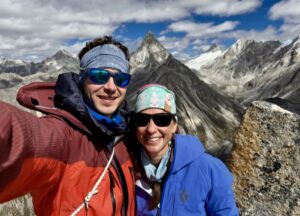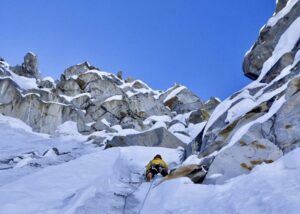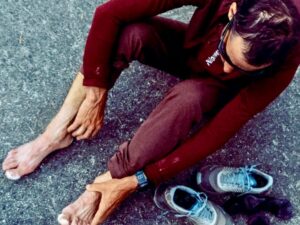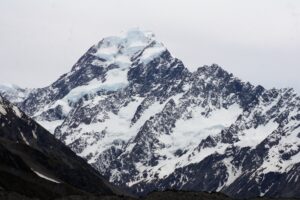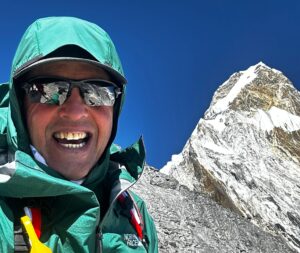Baintha Brakk I (7,285m), better known as Ogre I, has been attempted over 20 times. Only three expeditions have summited. ExplorersWeb dives into the history of this imposing granite tower.
The Karakoram presents some of the toughest mountaineering challenges on earth. Angular mountains, gigantic towers, dizzying ridges, unknown faces in remote places. It has always attracted the best climbers. Today, more than the 8,000’ers, it is the Karakoram’s 7,000m and 6,000m peaks that are the future of mountaineering. Here, exploration continues to play the most important role.
Panmah Muztagh is a sub-mountain range in the heart of the Karakoram. In the Baltistan district of Pakistan, it is made of four groups of mountains — the Ogre group, the Latok group, the Choktoi group, and the Chiring group.

The Ogre and the Latok groups include some of the world’s most challenging mountains for elite climbers. Photo: Thomas Huber
The Ogre
Baintha Brakk I (7,285m) is better known as Ogre I. Besides its main summit, it has two secondary peaks. Its west and east summits are both 7,150m. Like a violin standing upright, this steep granite tower, with a prominence of more than 1,800m, requires serious commitment.

The Ogre.
Over 20 expeditions have tried to climb it, but only three have managed to reach the summit.
The commitment begins at its often storm-battered Base Camp. From there, whichever route climbers choose hides danger. The weather is harsh and unpredictable, and the peak itself grants no respite. Once embarked on the ascent, the climber has to endure lack of oxygen, the endless lengths of its pillars, the challenging faces, the hanging seracs, and always, the ferocious winds.
The normal routes on 8,000m peaks have higher mortality rates, but then, far fewer people attempt the Ogre. There are no high-altitude tourists, you don’t pose for photos, you can’t get a helicopter directly to Camp 2, and there’s no one waiting for you with hot tea at the camps.

Doug Scott. Photo: Doug Scott
The first ascent
After three previous attempts, the main summit of the Ogre was climbed for the first time on July 13, 1977. British climbers Doug Scott and Chris Bonington ascended via the southwest spur to the west ridge, and over the west summit to the main summit. They made a quick push, 15 straight hours of climbing from their final camp. The last section of the climb was a tower with a 100m vertical face.

Doug Scott on the west summit of the Ogre, with the main summit to the right. Photo: Doug Scott
After reaching the summit, disaster struck. At 7,200m, at the start of the first rappel, Scott fell. The rope held, but Scott hit the rockface hard. He lost his goggles and ice ax and broke both legs. Bonington climbed down to him, and they spent the night in a bivouac on a ledge.
”It was a long night waiting for the first light of dawn, which was ages coming,” Scott recalled in his book, The Ogre. “There was no wind, no sound at all, just a penetrating cold kept at bay by involuntary shivering and creating friction heat by rubbing arms and legs.”

During the nightmare descent from the Ogre. Photo: Chris Bonington
It was a slow and technical descent, hanging from ropes and crawling in sections. Scott dragged his broken legs inch by inch down the Orge. Their companions, who were in Camp 2, gave them up for dead and began to descend.
A storm forced Scott and Bonington to shelter for two days in a snow cave. Bonington contracted pneumonia, so he too was very weak. Things got worse when Bonington fell on his side and broke two ribs. Despite everything, they continued to descend, helping each other with all their might.
Finally, they met their two companions, Mo Anthoine and Clive Rowland. Together, they were able to reach Base Camp after a week. There, they had to wait a long time for rescue. Somehow, everyone got out alive.
The second ascent
On July 21, 2001, Urs Stocker, Iwan Wolf, and Thomas Huber reached the summit via the south pillar. Bad weather forced them to take refuge in a crevasse at 5,000m. At first, they had a dispute with an American team that was on the same route and had to wait for them to withdraw.

Urs Stockers, Thomas Huber, and Iwan Wolf. Photo: Thomas Huber
They built Camp 1 at 5,000m and then slept in two porta-ledges fixed in the middle of the pillar, at 5,900m and 6,200m. The team made a final camp at 6,500m at the foot of the traverse to the main summit, which was 800m of mixed terrain. From there, they began their summit push on July 21.
The wind was very strong, but they were able to top out. The group also made the first ascent of the Ogre III.
The third ascent
Hayden Kennedy, Kyle Dempster, and Josh Wharton started up the southeast ridge, then moved up the southeast face, and finally a section of the south face.
The team had to struggle through a rubble traverse and climb on mixed terrain. They bivouacked at 6,900m. Wharton got sick, but Kennedy and Dempster continued to the main summit. On August 21, 2012, they topped out. The descent was very difficult because Wharton was still unwell.
In the same season, Kennedy and Dempster made the first ascent of the east face of K7 (6,934m).

During the ascent of the south face. Photo: Hayden Kennedy/Kyle Dempster
“I think alpine climbing comes down to 40 percent luck, 40 percent motivation, and 20 percent skill,” Kennedy said after the expedition. “You have to be really motivated to do that. You just keep building and dealing with the bad rock and dealing with whatever.”

Kennedy and Dempster ascending. Photo: Hayden Kennedy/Kyle Dempster
For this climb, the young climbers received the Piolet D’ Or.
Unfortunately, Dempster and Kennedy both died a few years later, Dempster on Ogre II in 2016, and Kennedy in 2017 in Montana. One day after his girlfriend died in an avalanche, Kennedy committed suicide. They were two unique talents.

Hayden Kennedy and Kyle Dempster on the summit of Ogre I. Photo: Hayden Kennedy/Kyle Dempster
Notable attempts
On June 15, 1983, French climbers Michel Fauquet and Vincent Fine completed 900m of the vertical south pillar without a fixed rope. They still had over 600m remaining to the summit, 400m of snow slopes, and more than 200m of rock. However, the weather turned and they had to wait in their bivouac tent.
On June 17, they tried to continue. They reached 7,100m before they decided to descend. They were very close, but the Ogre was not accommodating.
The south buttress
On August 5, 1993, a Swiss-German team led by Tom Dauer arrived at Base Camp. After two weeks of miserable weather, they fixed rope on the buttress up to 6,100m. They wanted to continue up the alpine-style route in two teams of three each. They made two attempts, but bad weather forced them to abort.
When the weather cleared on August 28, they tried again. The next day, Phillip Groebke fell while jumaring and died immediately. Nobody witnessed his fall to explain what went wrong. The group then retreated from the mountain.

Routes on the west and south faces of the Ogre. Photo: Montagnes Magazine
The southwest face
In 2002, a Japanese team attempted the southwest face. Japanese climbers are famous for attempting new routes, and the Ogre has many potential new lines. But the southwest face is very dangerous because of a large number of seracs. The Japanese team almost made it but had to turn around 10 to 15 metres before the summit.
Some climbers might claim a summit, but the Japanese climbers were clear: They did not summit the Ogre, even if they only missed by a few metres. Their honesty is commendable.
The southeast buttress
On July 12, 1993, Americans Tom McMillan, Peter Cercelius, and Carlos Buhler made Base Camp at 4,450m. They intended to start their route from the head of the Choktoi Glacier. A group of Japanese climbers was already working on the route through the icefall, but the seracs changed day by day. The Americans did not want to enter the icefall and decided to flank it on ice slopes and rock walls.
The ascent to the col was steep, with 12 pitches of mixed ice and rock climbing. The Japanese, who had already roped off this dangerous stretch, offered to share the route and the ropes. They were about to withdraw after 20 days of trying. Only seven of those days had provided good weather. The Japanese fixed six pitches on ice. They also left one pitch equipped on the 600m granite buttress.
The U.S. group advanced, but the weather deteriorated and they had to return to Base Camp. McMillan got sick. On August 30, after several attempts, Buhler and Cercelius began their push up the buttress. But with only three or four pitches left, they saw that they could not continue alpine style and so withdrew.

The Ogre from the air. The Uzun Brakk Glacier curls up from the left. The upper half of the South Pillar and the final summit tower are visible in this photo. Photo: Galen Rowell
The north face reconnaissance
Herve Barmasse and Daniele Bernasconi reached the foot of the north face of the Ogre at the beginning of July 2012. The north face is also dangerous, but Barmasse felt they had a chance. “There are weak points if you accept the constant exposure to avalanches and icefall,” he said.
They started to acclimatize. After nine days at or above Base Camp, they wanted to start the climb. However, July 12 to July 28 yielded only two days of fine weather. Instead, they went to other peaks and returned to the Ogre on July 28. When they returned, they saw that even the vertical rock walls were covered in snow.
The north face of the Ogre remains one of the greatest unsolved challenges in the Karakoram.


